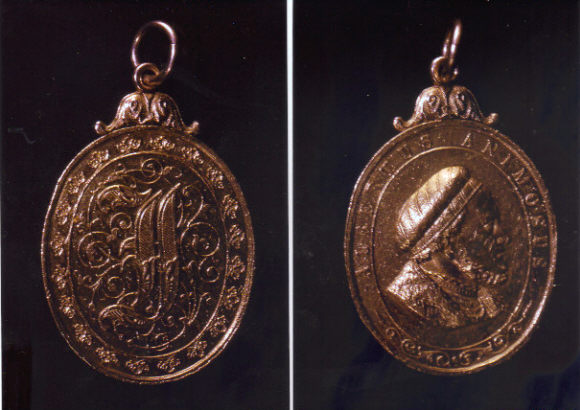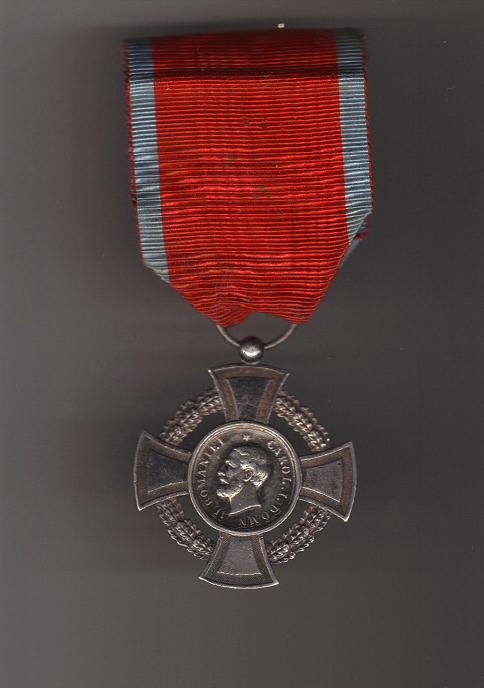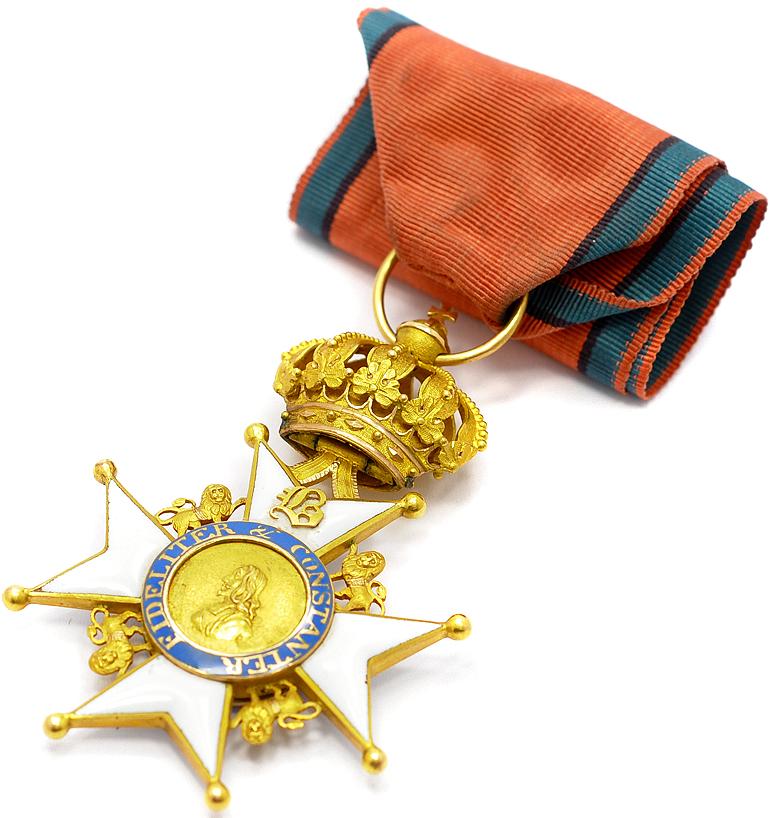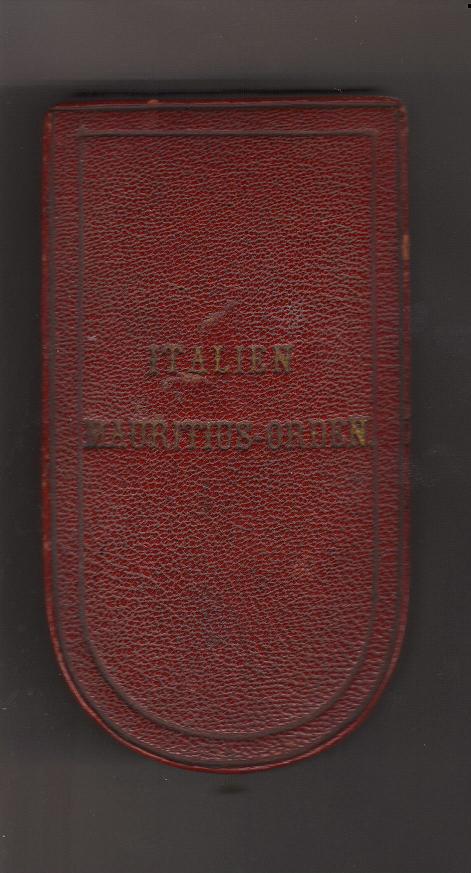-
Posts
809 -
Joined
-
Last visited
Content Type
Profiles
Forums
Blogs
Gallery
Events
Store
Posts posted by Yankee
-
-
A prized award for the lower ranks how excellent.
Thanks for that info you provived Beau.
0 -
Can anybody say what rank one would have been to be given the gold medal.
Thanks Yankee
 0
0 -

Came across this solid silver example. Thinking French due to the suspension & WWI era.
Pleae correct me if I'm wrong for Romania is new to me.
0 -
Hi David
What an excellent site that has great informative research & easy to navigate through. Nice that you totally devoted your site to the Golden Lion especially since there is so little info on this rare & early beautiful order on the net. Good wishes.

Sincerely
Brian
0 -
Thanks for replying guys. It's only 42mm so that would make it a Knight. Is the wrong(?) ribbon contributed to it being foreign-made or perhaps it's correct for bestowal to foreigners?
Hi RaZpuTin
Thanks for the size, you are correct that would make it a knight. Possible I'm incorrect about the country of manufacture. I know a good many of the early ones were of French make, after taking a really close look I think it is German after all. I think the ribbon should be the same for all.. I just have not seen enough of these to know about a special ribbon for foreigners.
0 -
This is a strange Saxe Ernestine. Foreign-produced? Never seen this kind of medallion and with the wreath missing.

Most likely French made due to the details of the crown. The cypher makes it an early piece, before 1864 to be certain.
0 -
This is a strange Saxe Ernestine. Foreign-produced? Never seen this kind of medallion and with the wreath missing.

Awarded to foreigners only without wreath. Very nice & rare piece

Is that a Knight 1st class or Commander?
Sincerely
Yankee
0 -
I heard some time ago from another collector that the rich blue center on the obverse were dated to be the oldest examples and later came the light blue. No answer to when this change took place. I can only confirm what he says by viewing a Franco-Prussian group that surprisingly had a Italian Officer Crown (rich blue enamel center) with what looked to be the orginal thick hand stitched rosette. Hope it helps.
0 -
Now... it would be very nice to see the fine Mayer's Söhne-made cross inside the case!
Beautiful piece indeed.
Enzo
 0
0 -
I can only quote the title of a pavian, composed by master Dowland: "flow, my tears"...
Enzo
Only for the Dual Monarchy :beer:
0 -
Brian,
Thank you. Yes, there are couple of 'Spanish crown' Officer crosses in my display case. LOH was certainly an influence with L1 Order's design and structure. Also, Dutch Miltary Order of Willem along with Royal Guelphic Order and even Order of the Bath (spanish crown - look at pre 1817 design of that Order and compare the crowns - many believe King wanted that particular crown on 'his' L1 Order).
I don't think Belgians simply copied LOH award system. 1832-1839 Commander class was different; 1839 Grand Officer was also unique (only breast star - no neck badge). More like LOH/Willem combination if anything. Swords were featured right from the beginning and many believe this was probably influenced by Guelphic Order. LOH did not use swords.
Size wise (for Knight/Officer) - Dutalis's (1st crown type) crosses were pretty much around 39-40mm. Allard's (2nd crown type) were mostly 40mm. Buls's earlier crosses - I have 2 as large as 43mm, his later (Buls's 2nd crown type) examples are for the most part around 40mm.
Some examples had been made to model French reduced-size crosses for wear. Those were mostly French-manufactured for the French recipients (probably as additional insignia). I have 2 early (french hallmarked for pre 1838) crosses that are 32/33mm.
Chancery awarded Belgian-made crosses so anything made in France or England is unlikely an issued piece; rather privately purchased second. This is of course in the realm of the earlier awards, say until 1880's or so. There were some early Commander's breast crosses (tinsel/bullion) made in France. I think Dutalis's examples were all in metal but those are super rare in any form as no longer issued after 1839.
'Spanish' crown type was manufactured solely by Dutalis. I have not seen a full sized French-made example with this exact crown.
Wolfers; Guillame came to Brussels in 1836 and did some work as jeweller, however I am yet to see a L1 Order from that time period by him. His son (Gustav) was born in 1846 - this is the name you will see most often on cases/plaques. It is not known if he produced any L1O insignia prior to Buls's death in 1878 (Buls had the contract). It is most likely that only around 1885 Gustave Wolfers got part of the contract to become supplier to the chancery of the Order.
Hope this helps.
Hi Kris
Thanks ever so much for your informative answers
 . Clearly there is a lot to digest on the individual jewelers. Interesting to note the measurements stayed nearly the same amongst the jewelers and the life of the order. Are their any (obvious or minute) differences in your Spainish officer examples that set them apart? I know from experience that no two examples are ever identical from the first few years of an orders creation. Surprised that English firms had manufactured the order. The examples must have been of very high quality. I agree with those that believe in the Guelph influence. The only order that comes to my mind at the time that used swords between the crown & cross.
. Clearly there is a lot to digest on the individual jewelers. Interesting to note the measurements stayed nearly the same amongst the jewelers and the life of the order. Are their any (obvious or minute) differences in your Spainish officer examples that set them apart? I know from experience that no two examples are ever identical from the first few years of an orders creation. Surprised that English firms had manufactured the order. The examples must have been of very high quality. I agree with those that believe in the Guelph influence. The only order that comes to my mind at the time that used swords between the crown & cross. Sincerely
Brian
0 -
An old friend.
Paul
She has a good home, & her little friend inside is absolutely adorable.
Thanks a lot Paul :beer:
0 -
-
Sometimes we come across a case that would be considerably more scarce than the order itself & this would be one of those times. An early made case for Saint Maurice & Saint Lazarus by V.MAYER'S SOHNE which confirms that Rothe was not the only supplier of orders & medals to the Italian States.
0 -
Here is my L1 collection case. Missing several things but who knows - in time some may show up.
Congratulations in putting such a fine collection together from the beginning of its inception

 On your officer row is tha a Espgnol type
On your officer row is tha a Espgnol type  ?The order looks very similar to the Legion Of Honor in design and class structure. Have the badges stayed fairly the same size in the last century and half or have they become larger? It is rare to come across the badges with the espagnol, bombe etroit & large bombe crowns. When I do come across such examples I see them to be small as 30mm and wide as 44mm. If the Begians did copy the French award system and stayed true to the French measurements , then the smaller early examples would be reduced sizes or by private jewelers to their interpretation or am I wrong. I assume the very early ones with the Espagnol Crown were made by French jewelers or were the Belgian firms such as Wolfers already in exstence?
?The order looks very similar to the Legion Of Honor in design and class structure. Have the badges stayed fairly the same size in the last century and half or have they become larger? It is rare to come across the badges with the espagnol, bombe etroit & large bombe crowns. When I do come across such examples I see them to be small as 30mm and wide as 44mm. If the Begians did copy the French award system and stayed true to the French measurements , then the smaller early examples would be reduced sizes or by private jewelers to their interpretation or am I wrong. I assume the very early ones with the Espagnol Crown were made by French jewelers or were the Belgian firms such as Wolfers already in exstence? Thanks for sharing
Sincerely
Brian
0 -
Does anybody have the statutes from the time of Carlo Alberto.
It would be nice to see a picture of the knight and know the size if that is mentionened as well.
Thanks in advance
0 -
Thats greatHello,
yesterday I've visited my mother and have found, in my father's library, an example of the 1816 statutes and a VERY erarly knight's cross, with "smooth" white enamel.
I hope this will be useful to all of us.
Best wishes,
E.L.
 Do let us know if the statutes mention the sizes of the knight.
Do let us know if the statutes mention the sizes of the knight.Sincerely
Brian
0 -
Hello,
in my late father's library there should be an ancient statutes' book of this order. I'll take it at home as soon as possible and search for possible details.
What I can say is that the crosses of the Order of St. Maurice & Lazarus had the St. Maurice cross with "smooth" white enamel in the pieces dating from the 18th Century. From the early 19th C., the "trefoil" shaped endings were even more and more raised, until they became like three "balls".
Best wishes,
Elmar Lang
Hi Enzo
You hit the nail on the head
 . That makes sence that the "trefoil" had gone though a transition over time. I recall seeing something like you described as being slightly raised. I just simply dismissed it as a foreign made piece or fantay
. That makes sence that the "trefoil" had gone though a transition over time. I recall seeing something like you described as being slightly raised. I just simply dismissed it as a foreign made piece or fantay  . With the Prussian Red Eagle we can date them through their design change, hopefully we can do the same accurate way with the Saint Lazarus & Saint Maurce. Please do let us know what you uncover.
. With the Prussian Red Eagle we can date them through their design change, hopefully we can do the same accurate way with the Saint Lazarus & Saint Maurce. Please do let us know what you uncover.Sincerely
Brian
0 -
Yankee,
Unfortunately I do not have VE I statutes (I've been trying to find them or even basic translation for quite some time).
Carlo Alberto's statutes (I have a shortened translation) defined Order's structure as:
- Knight (in two categories : Knight of Justice and Knight of Grace). Cross was small sized on ribbon (no crown). There were no limits to numbers.
- Commander; Cross was of larger (then Knight) size and worn with the neck ribbon. No crown. This class is said to be limited in numbers (my translation does not specify).
- Grand Cross; Cross still larger (then Commander) in size and with crown. Worn on sash ribbon. Breast star was to be worn on left side and was to have embroidered gold/silver rays between arms. GC was limited in numbers (also no indication in my translation).
Further, it specifes Order's uniform (along with hat, epaulettes and dress sword).
I think stars with embroidered rays were only used at the beginning since the all metal stars were the 'fashion' of the time. Most 'big' Orders were switching to them starting around 1820's or so (Austrians and the French did so).
Sadly, I do not have any of those early crosses in my collection but have seen (even handled) several in museums and 2 different collections. All seem to be made in gold and no 2 were identical. I doubt any one jeweller had a contract from chancery. Seems it became more 'organized' in that regard after 1851 secularization of the Order by VE II.
Yes, all of the Knight classes were rather small as far as I remember (maybe 20mm or so). Grand Cross looked gigantic in comparison. One thing I noticed was all Commanders had this swivelled-like suspension and relatively small ribbon retainer. I will try to contact one of my friends who have some examples and hope he'll forward some photos.
Take care.
Farmer
Hi Farmer
Fantastic that you were able to supply a translation of the statutes

Only once I ever had the chance to examine one up close, as I remember it was a commander grade in its orginal case from 1810 era and what was most striking about the badge was the Saint Lazarus being an aqua blue instead of the traditional green. The cross itself was flat and no crown. I noticed that the crowns also varied in style, fair to say too that no two crowns were identical. This would support at the time several jewelers not one royal court jeweler supplying the House Of Savoy. That would be splendid to have the possibility to see some early examples.
Sincerely
Yankee
0 -
Yankee,
I am not sure if this is what you seek but wasn't it Carlo Emanuele (Duke of Savoi) who made changes and merged insignia of both Orders into one. They wore them as an embroidered mantle badge and somewhat later made into neck badge in gold and enamels. This change took place some time before Duke's death in 1630.
I am not certain what exactly did Vittorio Emanuele I changed (in the 3 books dealing with statues and regulations of the Order) but major modification took shape during reign of Carlo Alberto on Dec. 3 1831. Examples (that I saw) dating from that period already had those raised round tips.
Does anyone know what was in those VE I period statues in regard to insignia?
Farmer
Hi Farmer
Thanks for confirming that the raised circular edges had already been in existence prior to 1830. In the Spada book there are several fine examples of flat crosses all dating back to the very early 1800's all of slightly different design. I suppose back then they were made by local jewelers. I suspect Vittorio Emmanuele had changed the order from a one class to a multi class award since nearly all the monarchs at the time had copied the award system that Napoleon had created to award all those in the field not just the Generals. Carlo Alberto went further to extend the class system unfortunately I do not know either what class he added for I too do not have those statuets.
It would be awesome to see the statutes from Vittorio Emmanuele & Carlo Alberto. Have you fotos of thes early examples or were they in a museum. Unfortunately examples from that period are seldom seen or they are and there all lumped together as mid 19th century examples since the design is the same. The examples you had saw should have been rather small in size from Carlo Alberto reign? Thanks
Sincerely
Yankee
0 -
-
Dear Gentlemen
Does anybody know what year the Saint Maurice went from being awarded in a smooth even enamel arm to a raised cicular edge arm. Thanks for any info provided.
0 -
I fully agree with Yankee, the monography published on the occasion of the 200 years jubilee of the Lepold Order (also available via the Oesterreichische Gesellschaft für Ordenskunde ( www.ordenskunde.at ) is an excellent work.
Only I can't agree with the opinion that a gold Rothe copy can't have differences with an original.
Original pieces of Rothe are much, much better than the best post-1918 piece from the same firm.
Best wishes,
Elmar Lang
Didn't know the site had a whole section on publications Enzo
 . That Maria Theresa exhibit catalog looks like a must. Luckily some of the publications can still be had
. That Maria Theresa exhibit catalog looks like a must. Luckily some of the publications can still be had 
Sincerely
Brian
0 -
For all those who collect the Leopold order there is an
 excellent monograph on the 200th anniversary. The monograph is richly illustrated with many fine early examples (obverse & reverse) & the measurements too. They can be purchased directly from Mr Rochowanski in Vienna. Better to know exactly how the orginals should be before gambling on one at the next show. There is a 1969 Rothe sales catalog that has all the orders in gold. And if your wondering how you can tell the difference
excellent monograph on the 200th anniversary. The monograph is richly illustrated with many fine early examples (obverse & reverse) & the measurements too. They can be purchased directly from Mr Rochowanski in Vienna. Better to know exactly how the orginals should be before gambling on one at the next show. There is a 1969 Rothe sales catalog that has all the orders in gold. And if your wondering how you can tell the difference  YOU CAN'T.0
YOU CAN'T.0






Albert Medal
in Germany: Imperial: The Orders, Decorations and Medals of The Imperial German States
Posted